
The ACT Science section is basically the white and gold dress of the ACT. It's blue and black or white and gold. It's either really hard or really easy, depending on the viewer. In this article, I'm going to help you find a strategy that makes the ACT Science really easy always.
As I mentioned in a previous article, the ACT Science section is more reading than science. Therefore, to do well on the ACT Science, you need to have a good reading strategy. Counterintuitive, I know.
While using one strategy for the whole ACT Science section would be ideal, there is no single technique that works to read all of the ACT Science Passages. Your approach to reading the ACT Science Passages should vary based on the type of passage. If you're unfamiliar with the 3 types of ACT Science Passages, I recommend reading our other article first.
In this article, I'll outline all of the ACT Science reading techniques that I've personally tried and taught to students. I'll rank the techniques from best to worst. I offer all of the strategies (instead of just one) because my favorite strategy may not work for you.
Summary of the Types of ACT Science Passages
As a brief review, there are 3 types of ACT Science Passages:
- 3 Data Representation Passages
- 3 Research Summary Passages
- 1 Conflicting Viewpoints Passage
Data Representation Passages and Research Summary Passages are very similar. Both use visuals (graphs, tables, etc.) as the primary way to convey information. We'll use the same 3 approaches to read both.
Conflicting Viewpoints Passages are the most unique since Conflicting Viewpoints Passages typically don't have any visuals. We'll use 2 different approaches to read this passage.
As I mentioned earlier, I offer 3 strategies for reading the Data Representation and Research Summary Passages and 2 strategies for reading the Conflicting Viewpoints Passages (as opposed to telling you what to do) because I have seen first hand as a tutor that every student thinks uniquely and that no single strategy works for everyone.

One-size-fits-all strategies work as well as one-size-fits-all pants.
Reading Strategies for Data Representation and Research Summary Passages
When trying to implement a reading approach for the ACT Science, you should not simply try the approach on one ACT Science passage and then give up and move on to the next strategy. The first time you try an approach, it will never work perfectly. If you have tried the approach on 2-3 full practice ACT Science sections and you still don't feel comfortable with it, then you should try another strategy. Start with approach #1 in your practice, and only move on if after significant practice it still doesn't work for you.
Approach #1: Skip the Passage and Go Right to the Questions.
Immediately start reading the questions. Try to answer all of the questions by using only the graphs, charts, and other visuals. If you need more information to answer a question, skip it and come back to it after answering as many questions as you can with the visuals alone. When you come back to it, skim the passage and try to answer the question again. Check out the below question as an example of how this technique works:
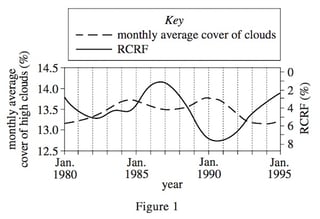

To answer this question, you just need to look at the graph. Locate January 1987, which is two ticks to the right of 1985. If you follow that tick up to the dotted line (which represents the monthly average cover of clouds), you see that it is approximately 13.5%, so the answer is B.
This is the best approach in my opinion. I’ve found it to be the most effective for me and for most students I’ve tutored. With only 52.5 seconds per question, this approach is the most efficient use of your limited time, especially if you find yourself running out of time before you get a chance to consider all the questions.
Approach #2: Skim the Passage and Then Read the Questions.
This is the second best approach. Try this approach if you struggle to answer the questions without having a little context first.
Skim the passage for key words that indicate what the passage is about, for key words that indicate trends such as increase or decrease, and for key words that suggest differences such as high, low, big, or small. You should circle or underline these terms as you skim. These are the terms that most questions refer to in the Data Representation and Research Summaries Passages. We'll apply this strategy to the passage below that accompanies the question above:
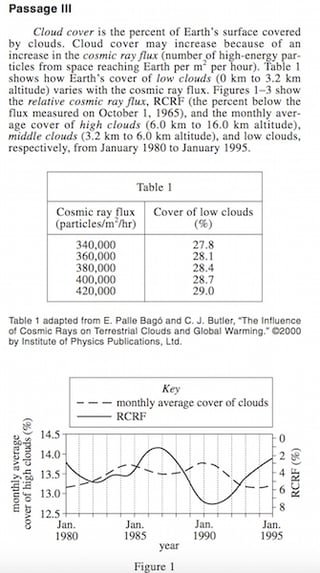
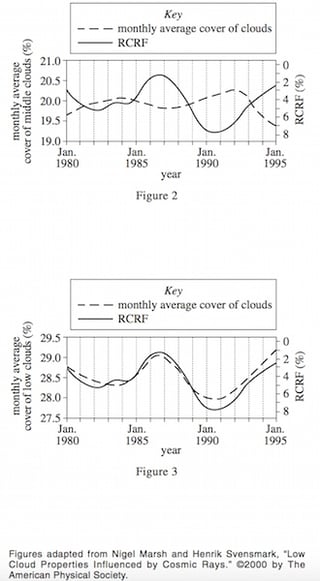
Skimming the above passage, I would grab onto key terms: cloud cover, increase, increase in cosmic ray flux, low clouds, relative cosmic ray flux (RCRF), high clouds, middle clouds. It's fine if you don't understand what each term means right away - if the term is important, it'll be clear from reading the question, and you'll have a chance to hone down on important terms later.
Now, when looking at question 13, I have a better understanding that the passage discussed 3 different heights of clouds. The question is just asking about high clouds, so I only need to look at figure 1. Then, I follow the steps I outlined above. Locate January 1987, which is two ticks to the right of 1985. If you follow that tick up to the dotted line (which represents the monthly average cover of clouds), you see that it is approximately 13.5%, so the answer is B.
Skimming first is not necessary and may slow some people down. However, if you get confused looking at the questions without any context, approach #1 may take you more time as you try to figure out what the question is asking you. Try approach #2 if, after you have attempted approach #1, you still struggle with timing, or you struggle to answer the questions correctly. If neither approach #1 nor approach #2 seems to be getting you to your score goal, as a last resort, try approach #3.
Approach #3: Read the Whole Passage First.
I don’t recommend it, but if the first two approaches do not work for you, you can use this as a last resort. See the passage above which goes with the question above related to high clouds.
Reading the whole passage first wastes a lot of time, since, as I explained above, you can get the answer to question 13 without reading any of the passage. It definitely will get you to the right answer, but you need to read very quickly if you want to complete all 7 passages.

Sad pony
If you plan on using this approach, you need to be able to read the passage/visuals in less than 2 minutes since you only have 5 minutes to complete each passage. Set aside at least 3 minutes to answer questions.
If you're targeting a score between 31 and 36 and are not able to get your reading pace under 2 minutes, DO NOT use this strategy, or you will not be able to finish all 7 passages. If you are targeting a score of 30 or below, you can afford to skip 1 passage, so you could use this strategy if your reading pace is slower. Make sure you can answer 6 out of 7 passages. I’d recommend skipping the Conflicting Viewpoints Passage if you skip 1.
Reading Approach for Conflicting Viewpoints Passage
Since the Conflicting Viewpoints Passages rarely have visuals, it would be ineffective to use approach #1 to answer Conflicting Viewpoints questions. Instead, you must take a completely different approach.
Approach #1: Read the Whole Passage First.
What? But you just said this is the worst strategy to use for Research Summaries and Data Representation Passages. Yes, I did.
This is the best strategy for the Conflicting Viewpoints Passage only. To answer Conflicting Viewpoints questions, you need to read the entire passage, so that you can distinguish between the scientist's/student's viewpoints. You should ask yourself these questions while you read:
- What does scientist/student 1 believe?
- What does scientist/student 2 believe? What does scientist/student 3/4/5 believe? Occasionally, there will be more than 2 viewpoints represented. I have seen as many as 5 viewpoints discussed on a Conflicting Viewpoints Passage.
- How is scientist/student 2's point of view different from scientist/student 1's point of view?
- How is scientist/student 2's point of view similar to scientist/student 1's point of view?
We will apply this technique to the passage and question below:
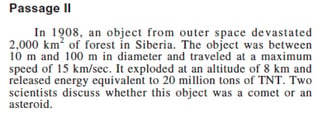


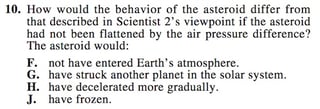
In order to answer this question, you need to read all of Scientist 2’s paragraph and understand what Scientist 2 believes. Scientist 2 said the object was an asteroid. Scientist 2 also said that as the asteroid entered Earth’s atmosphere, it was flattened and decelerated rapidly due to the dramatic increase in surface area.
In looking at the question, I can eliminate F because it had already entered Earth’s atmosphere when it flattened, which means I can also eliminate G. H makes sense because it decelerated rapidly due to increased surface area, if it had not flattened, it would not have had an increased surface area. I think the answer is H, but I will check J. Frozen doesn’t make any sense and was not mentioned in Scientist 2’s paragraph. So, the answer is H.
Notice that you need all of the information from the Conflicting Viewpoints Passage to answer the questions. Thus, reading the whole passage first is the most effective strategy. This way you ensure that you do not miss key information you need to answer the questions.
Approach #2: Skim the Questions and Then Read the Passage.
If you would like to skim the questions first to get a sense of what you should be reading the passage for, that is fine too. It may slow you down, so I recommend trying approach #1 first. If you had skimmed question 10 before reading, you would have known you had to pay special attention to Scientist 2’s description of the flattened asteroid. You would have been able to circle the sentence that mentions the flattened asteroid when reading through the passage. It might make answering the question a little faster.
Everyone is unique, so try approach #1 and if it slows you down too much, then try this approach. You will only find your best reading approach through practice.
How Should You Practice These Skills?
Method #1: By Practicing With Good ACT Science Specific Material
Duh, I know it's obvious, but it is worth saying. Because the ACT Science is so different from all other science and all other tests, the best way is to practice with the material that most closely matches the ACT Science test. For recommendations on study material, check out our article on best ACT prep books and download free printable ACT practice tests.
Also, check out PrepScholar's program. PrepScholar breaks down each ACT section into the skills you need to master, then gives you focused practice on each skill. This way you work on your weaknesses, whether that's interpreting data or understanding the basis for experiments.
Method #2: Reading Science Experiment Articles
If you want to supplement your practice, this is a good way, but it is not a replacement for real ACT Science study materials. Since the ACT Science Passages are similar, it will give you a leg up since you will already be familiar with reading this type of passage. You will be more familiar with the scientific method and looking at scientific data.
I recommend Science Daily. It is a free science news source, and the articles are very easy to understand. Check out this article about a study on peanut allergies. I recommend reading their articles as well as browsing the original journal article (which they link to at the bottom of their articles).
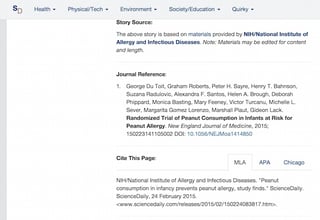
While Science Daily does not use many visuals on their site, the journal articles typically have unique graphs and visuals. Such as this one from the peanut allergy study:

When reading the Science Daily articles, you should ask yourself questions as a test. In particular, run through these questions:
- What is the main point of the experiment?
- What was the hypothesis?
- How were the experiments supposed to validate the hypothesis?
- When looking at the visuals in the related journal articles, what is being depicted?
This is how scientific research works, and this is what ACT Science expects you to be able to decipher. The concepts in actual science research papers are far more complicated than what the ACT Science will show you, but if you train on this more difficult material, ACT Science will be a breeze.
Actions to Take: A Recap
You need to have a good reading strategy to get a 36 on the ACT Science section. There is no one strategy that can be applied to the whole ACT Science section.
There are 3 different reading approaches for the Data Representation and Research Summaries Passages:
- Skip the passage and go right to the questions.
- Skim the passage and then read the questions.
- Read the whole passage first.
There are 2 different reading approaches for the Conflicting Viewpoints Passages:
- Read the whole passage first.
- Skim the questions and then read the passage.
Work with approach #1 first. If you have tried it on 2-3 full ACT Science Sections and it still doesn't work for you, then move on to approach #2. As a last resort, you can try approach #3 for the Data Representation and Research Summaries Passages. However, you need to get your reading time under 2 minutes, so that you can finish all 7 passages.
Again, find the approach that works for you and keep practicing it. Practice is the key to success on the ACT Science section. Practice with real ACT Science study materials.
What’s Next?
I hope this helps you find a reading approach that makes the ACT Science section easy (or the dress white and gold).
You don't need to be a science expert to do well on the ACT Science section. You just need to find an effective reading strategy that works for YOU. Practice this strategy, so that you excel the day of the test.
Learn more about the ACT Science section by reading about the 3 types of ACT Science passages, the only actual science you need to know for the ACT Science, what's tested on ACT Science, and the big secret of the ACT Science.
Like this article? Want to improve your ACT score by 4 points?
Check out our best-in-class online ACT prep program. We guarantee your money back if you don't improve your ACT score by 4 points or more.
Our program is entirely online, and it customizes what you study to your strengths and weaknesses. If you liked this Science lesson, you'll love our program. Along with more detailed lessons, you'll get thousands of practice problems organized by individual skills so you learn most effectively. We'll also give you a step-by-step program to follow so you'll never be confused about what to study next.
Check out our 5-day free trial:
Have friends who also need help with test prep? Share this article!

As an SAT/ACT tutor, Dora has guided many students to test prep success. She loves watching students succeed and is committed to helping you get there. Dora received a full-tuition merit based scholarship to University of Southern California. She graduated magna cum laude and scored in the 99th percentile on the ACT. She is also passionate about acting, writing, and photography.


































 Holly R.
Holly R.